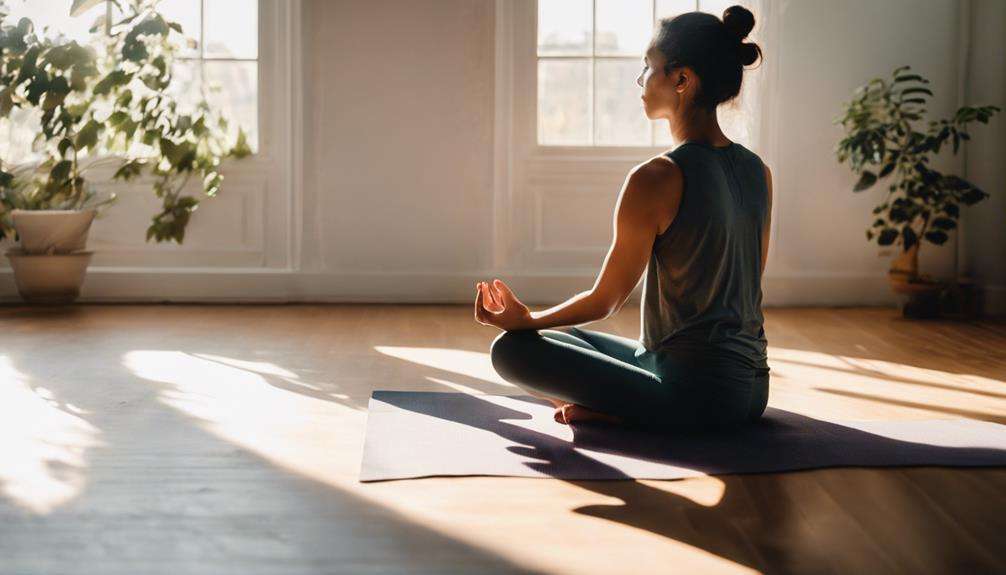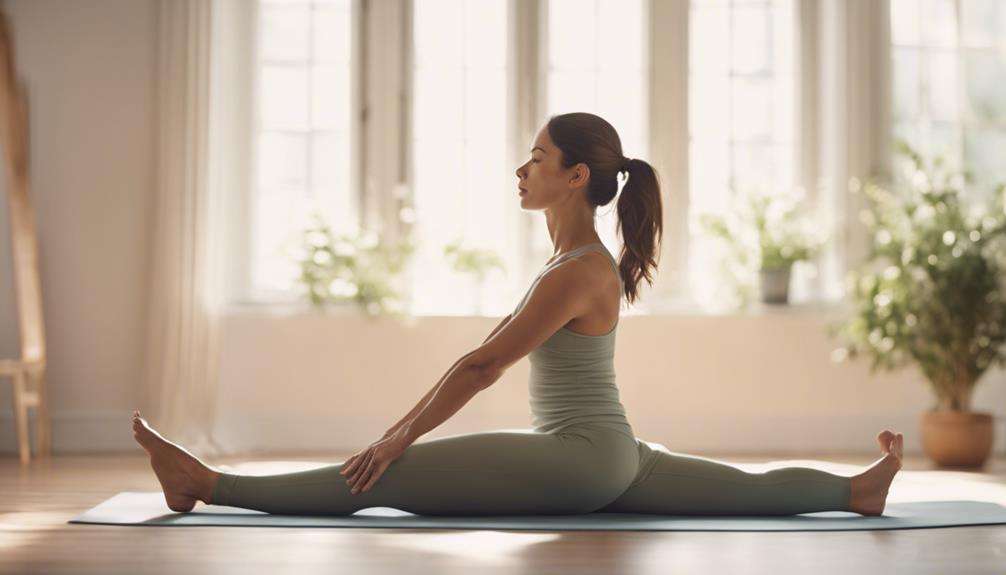If you've ever wondered how activities like yoga or tai chi can impact your blood pressure, the answer lies in the power of mindful movement practices.
By engaging in these exercises, you can actively contribute to the maintenance of healthy blood pressure levels.
The subtle yet profound ways in which these practices influence your body might just surprise you.
Explore further to discover the intricate connection between mindful movement and blood pressure regulation, and how these practices can potentially transform your well-being.
Key Takeaways
- Mindful movement practices like yoga and Tai Chi reduce blood pressure and improve cardiovascular health.
- Yoga and meditation aid in stress management, regulate blood pressure, and support heart health.
- Mindful breathing techniques induce calmness, reduce stress, and assist in blood pressure control.
- Dance therapy, Pilates, and walking offer holistic approaches to cardiovascular well-being and enhance fitness levels.
Benefits of Mindful Movement for Blood Pressure
By engaging in mindful movement practices like yoga and tai chi, you can actively reduce your blood pressure levels and improve your overall cardiovascular health. High blood pressure, also known as hypertension, is a common condition that can greatly impact your well-being.
Mindful movement activities offer a vital approach to stress management, which plays an important role in regulating blood pressure. These practices emphasize gentle movements synchronized with deep breathing, promoting relaxation and reducing the important effects of stress on your body.
Incorporating mindful movement into your routine can have profound effects on your cardiovascular health. By improving circulation and flexibility, these practices support your heart and overall well-being. Studies have shown that regular participation in mindful movement activities can lead to sustained improvements in blood pressure levels.
Understanding the Link Between Movement and Blood Pressure
Understanding how movement directly influences your blood pressure levels can provide valuable insight into managing your cardiovascular health effectively. Regular physical activity plays a vital role in controlling blood pressure levels.
Engaging in movement-based practices, such as yoga and tai chi, can help improve blood circulation, reduce the risk of hypertension, and promote overall well-being. By incorporating mindfulness techniques into your exercise routines, you can enhance relaxation and reduce stress, contributing to better blood pressure management.
Lifestyle interventions that combine movement with mindfulness offer a holistic approach to controlling high blood pressure. By being mindful of your physical activity choices and incorporating practices that focus on both movement and relaxation, you can support your cardiovascular health and work towards lowering your blood pressure levels effectively.
Take the time to understand how your movements impact your blood pressure, and consider integrating mindful movement practices into your daily routine for improved well-being.
Incorporating Yoga for Lowering Blood Pressure

To effectively lower your blood pressure, consider incorporating yoga into your daily routine for its proven ability to promote relaxation and reduce stress levels. Yoga offers a holistic approach to improving cardiovascular health, making it a valuable tool in managing blood pressure. Certain yoga poses, such as forward bends and gentle inversions, can help enhance circulation and aid in lowering blood pressure over time. By regularly practicing yoga, you can't only experience physical benefits but also mental well-being, which is essential for maintaining healthy blood pressure levels.
Additionally, the mindful breathing techniques incorporated in yoga practice can assist in calming the nervous system and regulating blood pressure. Studies have highlighted the effectiveness of yoga as a complementary therapy for individuals dealing with hypertension. By integrating yoga into your daily routine, you can work towards better blood pressure control and overall well-being. Embrace the soothing practice of yoga to support your journey towards lower blood pressure and improved cardiovascular health.
The Impact of Meditation on Blood Pressure
Curious about how meditation can impact your blood pressure levels positively?
Meditation has shown significant potential in lowering blood pressure among individuals engaging in mindfulness programs. By incorporating meditation into your routine, you can enhance blood pressure control through mindfulness practices. Mindfulness training encompasses various elements like attention control, self-awareness, and emotion regulation, all contributing to improved blood pressure management.
Participants who engage in mindfulness programs tend to adopt heart-healthy dietary habits and report reduced stress levels, which are key aspects of maintaining best blood pressure levels. The Mindfulness-Based Blood Pressure Reduction program specifically targets behavior modifications related to diet, physical activity, alcohol consumption, and stress management to support overall blood pressure control.
Research indicates that practicing mindfulness techniques can result in an average drop of 5.9 mm Hg in systolic blood pressure, showcasing the potential effectiveness of meditation in blood pressure management. Incorporating meditation into your daily routine can be a valuable tool in your efforts to maintain healthy blood pressure levels.
Mindful Breathing Techniques for Blood Pressure Control

Incorporating mindful breathing techniques into your daily routine can greatly contribute to better blood pressure control and overall well-being. By simply observing your natural breath without trying to manipulate it, you can induce a state of calmness and relaxation in your body. This practice is particularly beneficial for individuals dealing with hypertension or other cardiovascular issues. Mindful breathing helps reduce stress, anxiety, and tension, which are all factors that can negatively impact blood pressure levels. By focusing on the sensations of your breath, you can enhance your awareness and promote relaxation responses within your body.
Making mindful breathing a part of your daily life can be a simple yet effective way to support blood pressure control and improve your cardiovascular health. It's a practical technique that can be easily integrated into your existing routine, offering a natural and accessible method for managing hypertension. Start by setting aside a few minutes each day to practice mindful breathing, and gradually increase the duration as you become more comfortable with the technique. This small lifestyle change can have significant benefits for your overall well-being.
Tai Chi and Qi Gong for Blood Pressure Management
Tai Chi and Qi Gong offer gentle movements that promote relaxation and provide benefits for your mind-body connection. These practices are known to help lower blood pressure and enhance cardiovascular health, making them valuable tools for managing hypertension.
Gentle Movements for Relaxation
For those seeking relaxation and improved blood pressure management, exploring gentle movements like Tai Chi and Qi Gong can be beneficial.
These practices, with their slow, flowing movements, deep breathing techniques, and mindfulness focus, are known to reduce stress and promote overall well-being. Research shows that regular participation in Tai Chi and Qi Gong can aid in lowering blood pressure and enhancing cardiovascular health.
Regardless of your current fitness level, Tai Chi and Qi Gong are accessible and can be easily integrated into your daily routine. Engaging in these gentle movements not only supports blood pressure management but also contributes to improved balance, flexibility, and mental clarity.
Start incorporating Tai Chi and Qi Gong today for a healthier mind and body.
Mind-Body Connection Benefits
Discover the profound benefits of the mind-body connection through Tai Chi and Qi Gong for managing high blood pressure. These ancient practices have been extensively studied in cardiovascular science, showing remarkable effects on blood vessels. By engaging in Tai Chi and Qi Gong, individuals can experience reductions in both systolic and diastolic blood pressure, enhancing overall cardiovascular health.
The slow, deliberate movements, deep breathing, and meditation involved in these mindful practices promote relaxation and stress reduction, essential elements for blood pressure management. Additionally, Tai Chi and Qi Gong not only benefit physical health by improving flexibility and balance but also contribute to mental well-being.
Incorporating these practices into your daily routine can complement traditional treatments, leading to a better quality of life.
Dance Therapy for Lowering Blood Pressure

Dance therapy, with its focus on movement and expression, offers a holistic approach to improving physical, emotional, and mental well-being, which can positively impact blood pressure levels.
Engaging in dance therapy sessions not only allows you to express yourself through movement but also helps in reducing stress, anxiety, and depression, all of which are factors contributing to high blood pressure.
Studies have shown that dance therapy can lead to improved cardiovascular health by enhancing circulation and overall fitness. The incorporation of music, rhythm, and social interaction in dance therapy sessions can bring about a sense of joy and relaxation, further aiding in lowering blood pressure levels.
Walking and Blood Pressure Regulation
Engage in regular brisk walks to effectively lower your high blood pressure and improve cardiovascular health. Walking for just 30 minutes most days of the week can make a significant impact on your blood pressure levels.
Studies show that incorporating uphill or varied terrain walking can further enhance the cardiovascular benefits, aiding in better blood pressure control. On average, regular walking can reduce systolic blood pressure by 4-9 mm Hg.
The beauty of walking is its accessibility and low-impact nature, making it an easy exercise to integrate into your daily routine for blood pressure management.
Pilates for a Healthy Blood Pressure

Enhance your cardiovascular health and lower your blood pressure through the gentle yet effective practice of Pilates. Pilates is renowned for its low-impact nature, focusing on core strength, flexibility, and body awareness, all of which contribute to better cardiovascular health. By engaging in regular Pilates sessions, you can improve your posture, muscle tone, and balance, thereby supporting your overall heart health.
Additionally, Pilates incorporates mindful movement and breathing techniques that aid in stress reduction, a vital factor in managing high blood pressure. Studies have indicated that Pilates not only assists in weight management but also enhances circulation, both of which are beneficial for regulating blood pressure levels. The controlled movements and emphasis on proper alignment in Pilates make it a safe and effective exercise option for individuals seeking to support their heart health and maintain healthy blood pressure.
Embrace Pilates as a holistic approach to improving your cardiovascular well-being and managing high blood pressure.
Frequently Asked Questions
What Are the Mind Body Exercises to Lower Blood Pressure?
To lower blood pressure, try integrating yoga poses, breathing exercises, and tai chi movements into your routine. These mindful practices can enhance relaxation, balance, and focus, supporting your cardiovascular health and well-being.
What Are Relaxation Techniques to Lower Blood Pressure?
When looking to lower blood pressure, consider relaxation techniques like deep breathing, visualization, muscle relaxation, guided imagery, yoga, or tai chi. These practices can help you calm your mind and body, supporting better cardiovascular health.
What Are the 3 Exercises in the Blood Pressure Program?
For the blood pressure program, focus on chair yoga to relax, walking meditation to center yourself, and Tai chi for gentle movement. These practices improve overall well-being and help lower blood pressure effectively. Try them out!
What Type of Meditation Lowers Blood Pressure?
Guided imagery, mindfulness, deep breathing, visualization, progressive muscle, loving kindness – various meditation types can help lower blood pressure. Practice regularly for stress reduction, positive emotions, and relaxation benefits that contribute to improved cardiovascular health.
Conclusion
As you move mindfully through your day, remember the power of gentle movements and deep breathing to lower your blood pressure.
Whether you choose yoga, tai chi, meditation, or simply taking a walk, each practice offers a pathway to relaxation and improved well-being.
By incorporating these mindful movement practices into your daily routine, you can take control of your blood pressure and your overall health.
Embrace the calm and feel the benefits flow through you.






